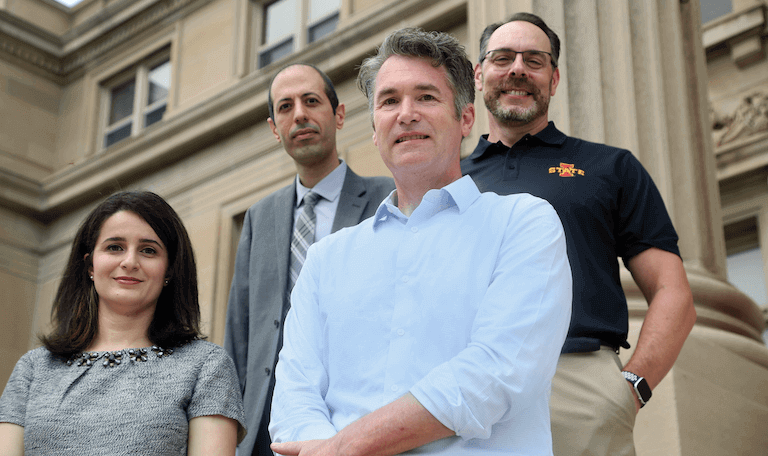Iowa State Researchers Receive 2021 Bridging the Divide Grant to Address Disaster Response
By Caitlin Ware, Iowa State University Office of the Vice President for Research
Posted Sep 14, 2021

By Caitlin Ware, Iowa State University Office of the Vice President for Research
Posted Sep 14, 2021

The damage natural disasters like tornadoes and floods inflict is often immediate. But a community’s ability to successfully rebound from the impacts of these disasters is tied directly to its ability to assess damage just as quickly and efficiently in order to restore the functionality of civil infrastructures.
A team of Iowa State University researchers selected to receive the 2021 Bridging the Divide seed grant is on a mission to provide communities with a novel platform that can streamline damage assessment and put them on a faster road to recovery.
The Bridging the Divide seed grant program is administered by the Iowa State Office of the Vice President for Research (OVPR). The program is designed to holistically address societal problems by fostering collaboration between researchers in design, arts, humanities and social sciences and researchers in STEM disciplines. The recipient team of the 2021 award consists of:
The team will receive $25,000 in institutional funding over two years to investigate methods of expediting post-disaster safety assessments of structures — particularly amidst health-related challenges, such as the COVID-19 pandemic — using a multidisciplinary platform that will incorporate engineering, societal, and educational aspects.
In the aftermath of extreme events, damage assessment of civil infrastructure components, such as buildings, highways, and utilities, is crucial to the disaster recovery process. Not only is it necessary for evaluating safety and determining property loss, it also serves as a catalyst for community restoration and resiliency. But all too often, professionals trained for inspection of damaged structures are not immediately available due to geographical unavailability or staff shortages (an issue exacerbated by the COVID-19 pandemic), which can delay post-disaster safety and condition assessments by weeks or months. When these delays drag on for too long, economic and societal risks surface, including the chance that individuals might leave their damaged towns of residence and never return.
Shafei, Winer, Alipour, Peters, and Gleason’s project, titled “Community Involvement for Responding to Extreme Events on Top of a Pandemic,” will focus on evaluating and improving the technical and social factors associated with post-disaster damage assessment. Together, the team hopes to address disaster recovery challenges by harnessing the hidden capacity of the population perhaps best equipped to observe the damage inflicted on communities: the people who live there.
The project will establish a data-informed computational platform, supported by virtual reality simulations, capable of replicating post-disaster safety and condition assessment scenarios for citizen training purposes. Once completed, the platform will serve as a tool for collecting firsthand data provided by community members for assessing damage and measuring urgent government aid and insurance coverage needs.
“This research project is among those that truly require a multidisciplinary effort to achieve success,” Shafei said. “With a complementary set of background and expertise, our team has an opportunity to conduct ground-breaking research that will dramatically change how disasters are assessed and responded to.”
By utilizing partnerships with various volunteer groups based in Iowa, the team believes it can elevate the level of “citizen science” needed to collect high-quality damage assessment data that can be effectively transformed into the information required for community resilience.
“Our proposed platform will combine holistic sensing by non-expert volunteers and decision making by responsible authorities to greatly enhance the resilience of communities and ultimately facilitate a more rapid recovery after natural disasters, especially when conventional resources are limited or unavailable due to pandemics,” Peters said. “This award is a unique opportunity to bridge the rural social sciences and engineering to address this important issue and explore the connections between infrastructure design, disaster preparedness, and community social capital.”
During the first year of the project, research activities will focus mainly on surveying select communities and civil infrastructures impacted by extreme events, including residents of Story County, Iowa, where a derecho struck in 2020, destroying several structures used for residential and business purposes. In the second year of the project, the collected data representing the needs of communities and emergency management agencies will be used to explore the strategies needed to maximize public participation in the platform.
“There have been too many instances, both in our state and across the country, of communities that have been unable to recover from natural disasters due to the many complex issues that arise,” said Vice President for Research Peter Dorhout. “I commend Doctors Shafei, Winer, Alipour, Peters and Gleason for coming together to identify a multidisciplinary solution that can provide communities with the tools they need to be more resilient in the face of disaster.”
The Bridging the Divide seed grant program, offered in partnership with the Center for Excellence in the Arts and Humanities (CEAH), is open to all Iowa State University full-time tenured or tenure‐eligible faculty. More information about the application, review, and award process can be found here.